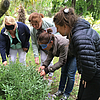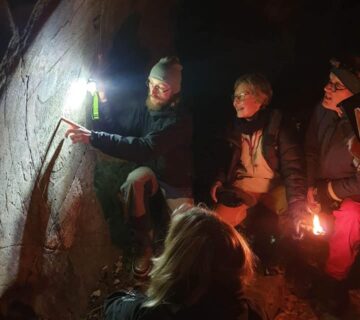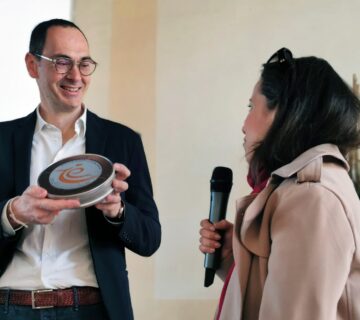How can such rugged landscape yield such sweet products, smells and colours?
An interpretative walk through the stony countryside can give us answers.
This May, I took part in an IE Interpretive Guide course, Run by Sandy Colvine, in the lovely countryside of Venasque in Provence. It was a sensory-packed experience. Together, alongside my training partner, Siobhan Geoghegan (an independent tourism consultant in Ireland), we forged the link between the landscape and the famous notion of ‘terroir’ in Provence. Using all our senses and the interactions between them, we brought a surprising and unsuspecting world to life. These are the marvelous opportunities that heritage interpretation can offer and here are some examples.
At first, we invited our fellow trainees to plunge into the fields of aromatic plants using only touch and smell, eyes veiled. This heightened their concentration and allowed them to deeply feel the multi-layered scents of thyme, lavender, rosemary and sage.
Then, we discovered the rich heritage and significance of the olive tree. We all know about olive oil, right? But do you know what makes green and black olives different? Siobhan told us that those two olives are in fact the same, but harvested at a different time. The green ones between September and November – before fully ripening – and the black ones later, not before December. The most important thing is that we finally got to taste them – green or black, I love them both!
How can we speak about Provence without mentioning the vineyards? We prepared a grape juice tasting. Where does this so pronounced taste come from? The answer: from the ground. In fact, the stones warm during the day and radiate their heat at night. To make the most of this natural phenomenon, grapevines are structured in a V-shape. But a picture says a thousand words!
Ok, so to conclude, the links between our senses, our knowledge and our creativity transform those moments into unique experiments that stay in our mind. That’s the valuable interaction that heritage interpretation can offer in so many different ways.
Anaïs Leroux is a landscape architect, specialising in heritage interpretation and historic gardens. She founded Les ateliers bucoliques (http://www.lesateliersbucoliques.com/) which makes landscapes and gardens come alive through senses, facilitation and guidance. She also chairs the Racines Association, a network of the historic garden specialists in France (http://www.association-racines.com/). You can contact Anaïs at: les.ateliers.bucoliques@gmail.com.
To cite this article:
Leroux, Anaïs Leroux (2017) ‘A multi-sensory discovery of the Provencal landscape and ‘terroir”. In Interpret Eu-rope Newsletter 2-2017, 14-15.
Available online:
www.interpret-europe.net/fileadmin/Documents/publications/Newsletters/ie-newsletter_2017-2_summer.pdf




